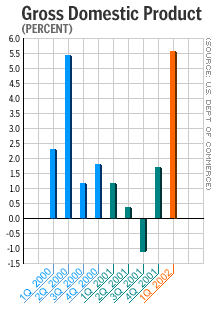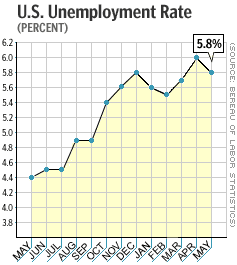
NEW YORK (CNN/Money) -
The outlook for the U.S. economy was still cloudy Thursday after a series of reports that showed falling weekly jobless claims, a record trade deficit and a gain in leading economic indicators.
None of the data seemed likely to move the nation's central bank to take action on interest rates after its next policy meeting, scheduled for next Tuesday and Wednesday.
The Labor Department said the number of Americans filing new claims for unemployment benefits fell to 393,000 in the week ended June 15 from a revised 395,000 the prior week. It was the third straight week that new claims were below 400,000, a level that points to a sluggish job market. Economists, on average, expected 385,000 new claims, according to Briefing.com.
"[This] suggests that the little lull the economy went into in the second quarter may be ending and that the labor market may be strengthening a little bit as we head into summer," Joshua Feinman, chief economist at Deutsche Bank Asset Management, told CNNfn's CNNmoney Morning program.
Separately, the Commerce Department said the U.S. trade deficit rose 10.7 percent to a record $35.9 billion in April from $32.5 billion in March. Economists expected the deficit to fall to $32.2 billion, Briefing.com said.
Imports rose 4.7 percent to $116 billion while exports rose 2.2 percent to $80.1 billion. While a surge in imports usually points to stronger domestic demand -- good news for the economy -- the latest jump could be skewed by importers' fear of a dock-worker strike in California.

The Commerce Department also said the current account deficit, which combines the gap between imported and exported goods, services, income and investment, jumped to a record $112.5 billion in the first quarter from $95.1 billion in the fourth quarter.
Together, the trade and current account deficits could further weaken the dollar, and the wider trade deficit likely will make second-quarter gross domestic product (GDP), the broadest measure of the economy, much lower than the first quarter's 5.6 percent gain.
Separately, the Conference Board, a private research firm, said its index of leading economic indicators rose 0.4 percent in May to 112.2 after falling 0.3 percent in April. Economists, on average, expected the index to rise 0.2 percent, according to Briefing.com.
"This is a pretty good number, still consistent with the view that the economy continues to improve slowly but surely," said Christoph Bianchet, U.S. economist at Credit Suisse Asset Management.
And the Philadelphia Federal Reserve Board's index of mid-Atlantic region manufacturing activity skyrocketed in June to 22.2 from 9.1 in May. Economists expected an index of just 11, according to Briefing.com. It was the sixth straight month the index was above zero, indicating growth in the sector.
U.S. stock prices were lower following the reports, while Treasury bond prices fell.
Threats to the economy
Constant worries about corporate accounting have helped keep stocks lower and could inspire foreign investors to put their money elsewhere. Many economists see the swelling current account deficit and worry that the United States relies too much on foreign investment; if that money source dries up, the value of the dollar could plummet, crippling the economy.
| |
 Related links
Related links
| |
| | |
| | |
|
"This shows our big reliance on imports and foreign capital. As the dollar weakens, that becomes a more and more expensive habit," said Brown Brothers Harriman economist Lara Rhame, a former Fed economist. "It makes our imports more expensive, makes the trade deficit wider, makes us even more dependent on foreign capital, weakening the dollar, on and on -- it's a vicious cycle."
"So far, the dollar's slide has been relatively constrained," Rhame added. "As long as it remains an erosion and not a plunge, this is a natural part of recovery."
Another potential threat to the economy is a looming strike by dock workers in California ports. The International Longshore and Warehouse Union's contract with port management expires on July 1, and negotiations are continuing.
Bear Stearns analyst Ed Wolfe said in a research note that activity in the second- and third-biggest California ports exploded in May as importers hurried to get goods into the United States in advance of a possible strike. A work stoppage could virtually shut down U.S. trade with many of its major partners.
Fed likely on hold
In the employment report, the four-week moving average of jobless claims, which smoothes out fluctuations in the weekly data, fell to 396,250 in the week ended June 15 from a revised 403,500 the prior week.

Continued claims, the number of people who have been drawing unemployment benefits for more than a week, rose to 3.78 million in the week ended June 8, the latest data available, from 3.75 million the prior week.
The labor market still is recovering slowly from more than a million job cuts last year, and it could be several months before companies begin rehiring workers in great numbers.
Unemployment fell to 5.8 percent in May, but it has been at or near that level since December. Companies are not likely to start hiring workers again until they see sufficient growth in demand for their products and services following a recession that began in March 2001.
"There is at least some light at the end of the tunnel, but unfortunately it is still a long way off," said Ian Shepherdson, chief U.S. economist at High Frequency Economics Ltd.
To keep consumers spending during the downturn, the Federal Reserve cut its target for short-term interest rates 11 times in 2001 to a 40-year low. Fed policy makers meet next week to discuss interest rates and are largely expected to leave rates alone, as they've done all year.
None of the 22 economists surveyed by Reuters on Wednesday said they expected a Fed rate cut next week, and 14 expected the Fed to leave rates alone until November. Three economists thought the Fed would leave rates alone all year.

|

